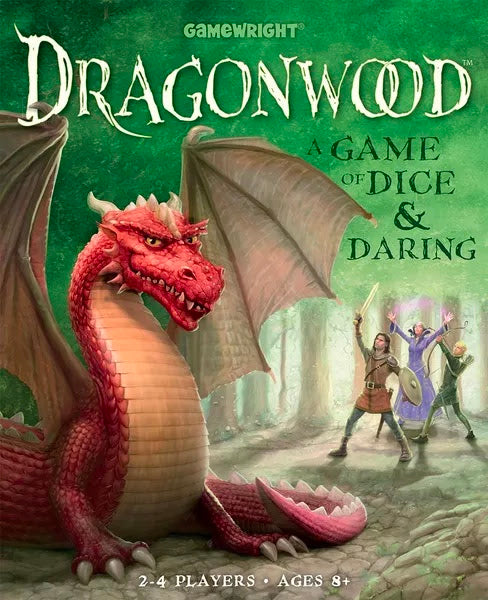Dragonwood Game Review. The perfect game for intrepid adventurers.

We've noticed over the years that some game publishers have a Midas touch. Or, at least, they are just a wee bit more discerning. Either way, Massachussetts-based publisher GameWright have won our admiration and respect: Forbidden Island, Forbidden Desert, Outfoxed, Loot, Sushi Go, Qwixx, and Sleeping Queens are just some of their titles that we love.
And, of course, Dragonwood.
It has taken me some years to fully appreciate how good Dragonwood is.
It is a wonderful introductory fantasy dice game for kids, leading hopefully to the exploration of other wonderful fantasy dice games: Dice Throne, Champions of Midgard, Chronicles of Avel... or even the big one, Dungeons & Dragons.

But it could also be recognised as a great maths teaching tool. A large part of the game of Dragonwood hinges on the judgement and manipulation of probabilities.
And kids don't necessarily even realise it, because they are having too much fun.
So what is Dragonwood all about?
You are taking a nice stroll through the Dragonwood Forest; or at least, you are attempting to. Strange creatures inconveniently stop you in your tracks, and you need to defeat as many of these as you can to collect points.
To attempt to "capture" a creature, you need to discard cards from your hand.
The cards must be either sequential (5, 6, 7, etc), or matching in either colour or value. The number of cards that you play equals the number of dice that you roll for the capture attempt. And every creature has its own set of target values - so the question becomes, how many dice do you need to hit a target? How many precious cards do you need to spend?

Let's take, perchance, a Hungry Bear. To successfully "strike" a Hungry Bear, you need to roll a target of 7 or better. Are you likely to roll a 7 with only two dice? If you don't need three dice, you could waste a card by playing three cards.
To make the question more intriguing, the dice in Dragonwood are not numbered 1 to 6! They have a 1, 2, 2, 3, 3, and 4 on their sides. You can roll a maximum sum of 8 with two dice, and a minimum of 2.
I'm one of those personality types that has to explore these things with a spreadsheet, and, you have only a 14% chance of rolling a 7 with two Dragonwood dice. Less than one chance in seven. Ouch.
What if your target number is a 6?
The value of games like Dragonwood in the classroom, I feel, should not be underestimated. Whole math lessons could be built around this game... not least because the game itself is so much fun!
Aside from the educational potential, I am surprised by the subtlety in Dragonwood. You actually have three ways of "capturing" a creature. You can "Strike" them with cards that are in sequence (like a "run" in rummy), or "Stomp" them with cards that are all the same number, or "Scream" at them with cards that are all the same colour. Each of these attacks have their own target value. The Hungry Bear has a Strike value of 7, a Stomp value of only 6 - the best approach - and a Scream value of 9. Screaming at Hungry Bears isn't a terribly effective strategy, it turns out.
This adds a delicious dimension of card play to the game. The fine art of Dragonwood is to be thinking about your next turn, even while playing your current one.

It is almost imperative to spin a story as you play. Did Goldilocks visit the Hungry Bear? Exactly why is the Giggling Goblin giggling?
Additional thoughts.
If there is one thing that I wish GameWright had done, it is an official cooperative variant for Dragonwood, where players are working together to capture creatures and defeat the two dragons that ultimately appear. Since there isn't any official rules for such a version, I've been, um, tinkering a little with my own unofficial ideas. I won't bore readers with them here, but if you would like to know more, please email me!
If you haven't explored Dragonwood, and you have intrepid adventurers in your family, it comes with our highest recommendation.
Or if you want to take your explorations a step further, the follow-up game Dragonrealm is also back in stock! Dragonrealm takes the successful Dragonwood formula and adds another gentle layer of strategy. But that's for another post...
2–4 Players
20 Min Playing Time
Age: 8+
(Dragonwood is also available to be purchased in store from our brick and mortar store if you're lucky enough to be local to Bunbury, Western Australia!)
Would you like more in depth instructions on how to play? Here's a wonderful video tutorial with detailed instructions on how to play Dragonwood.


